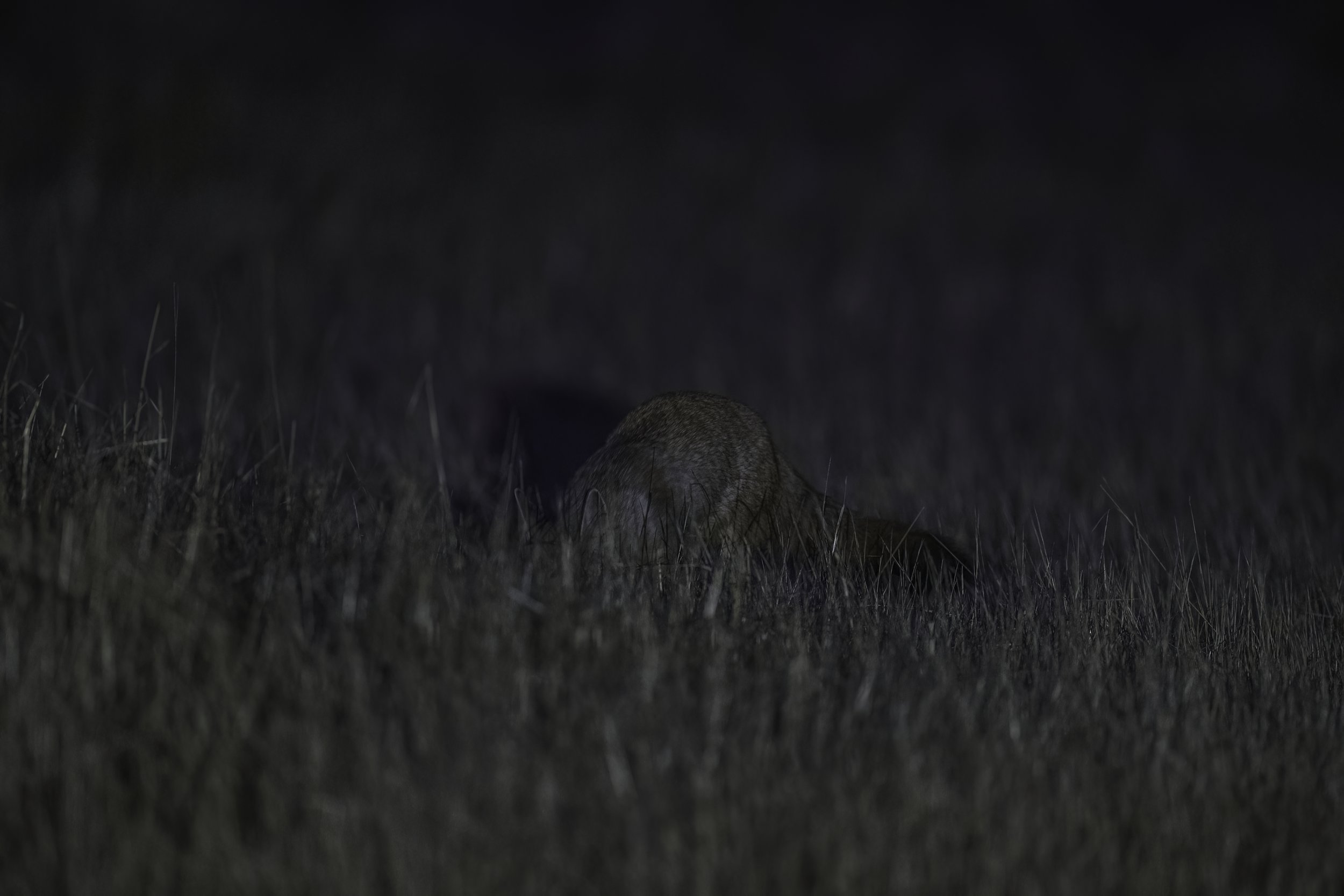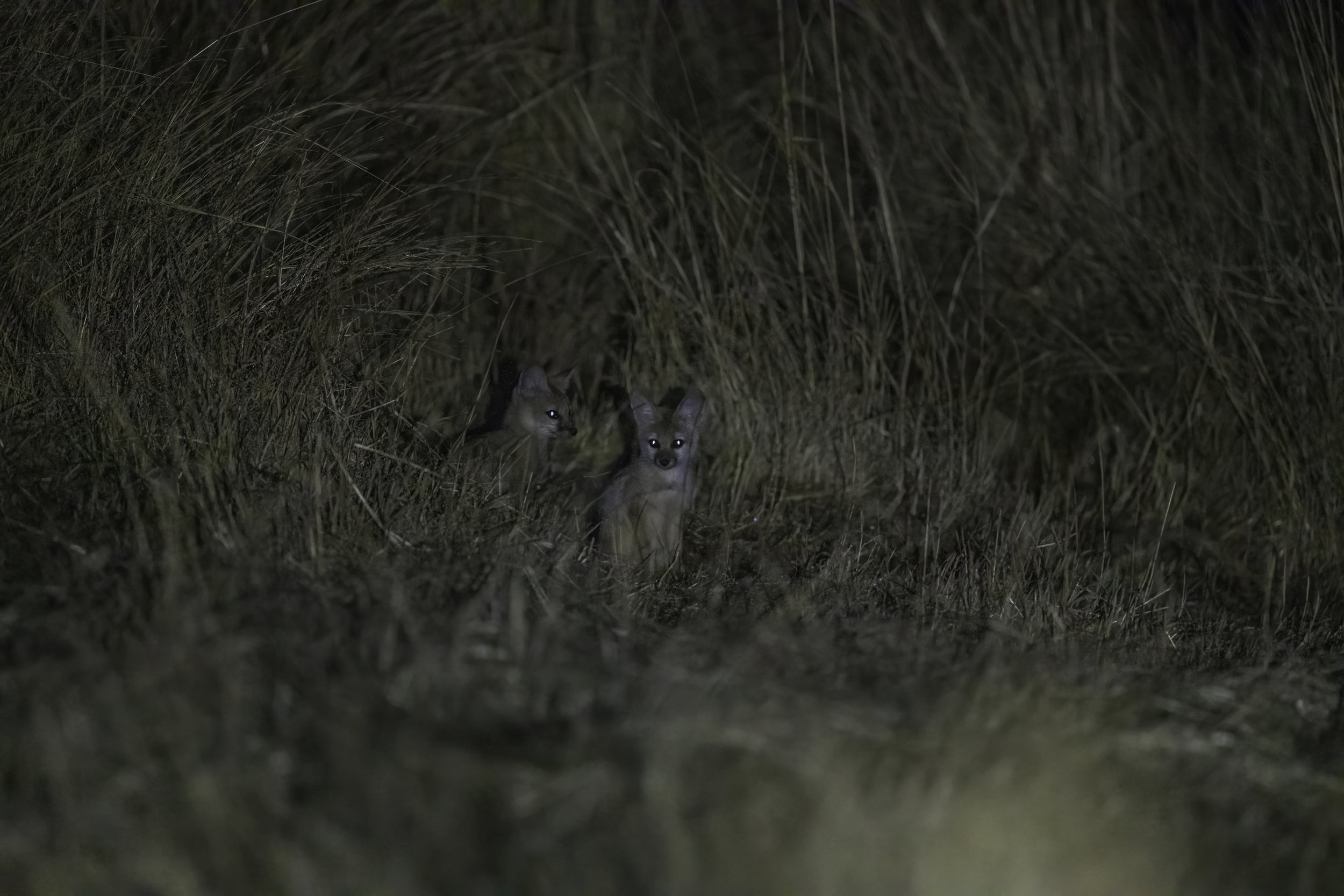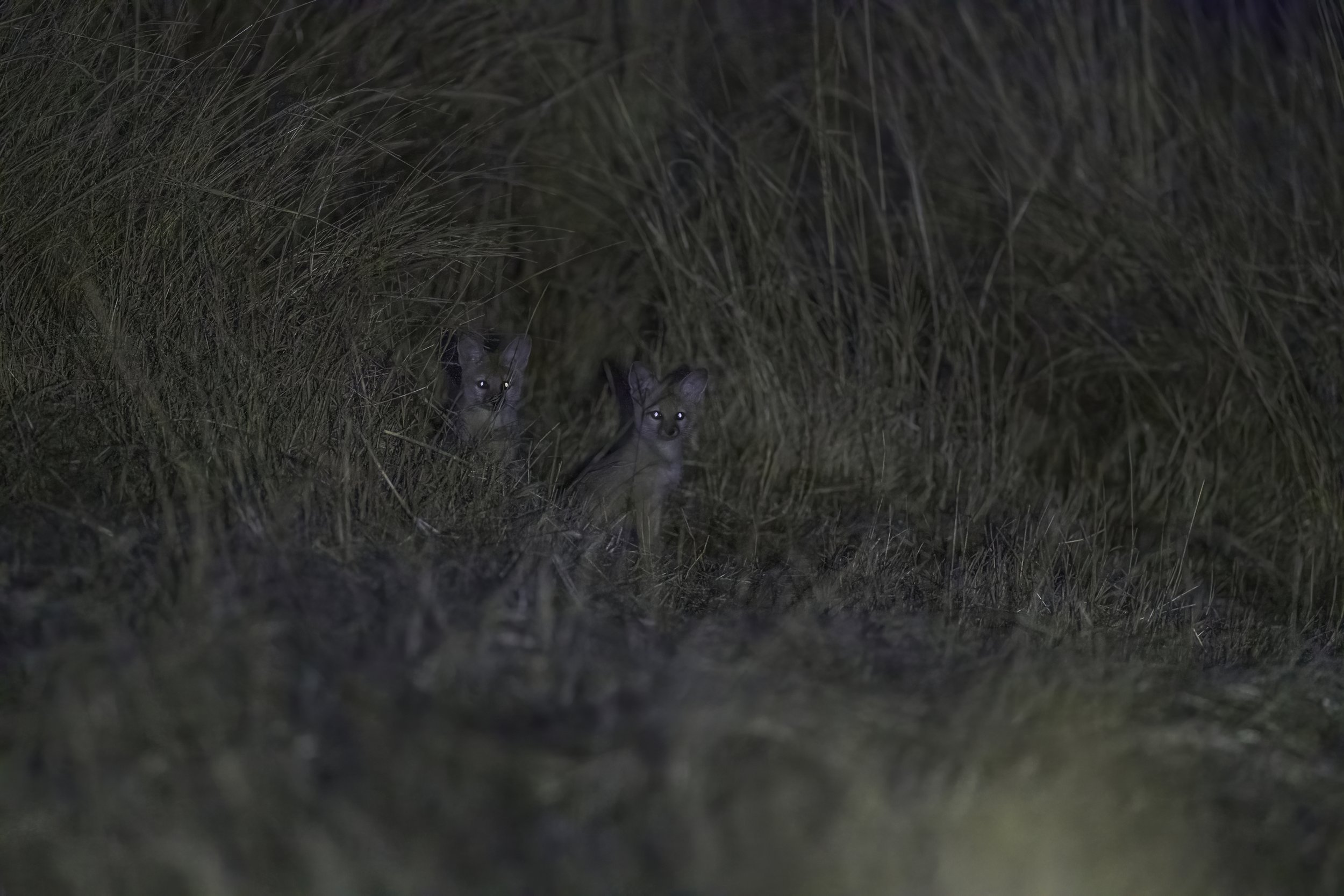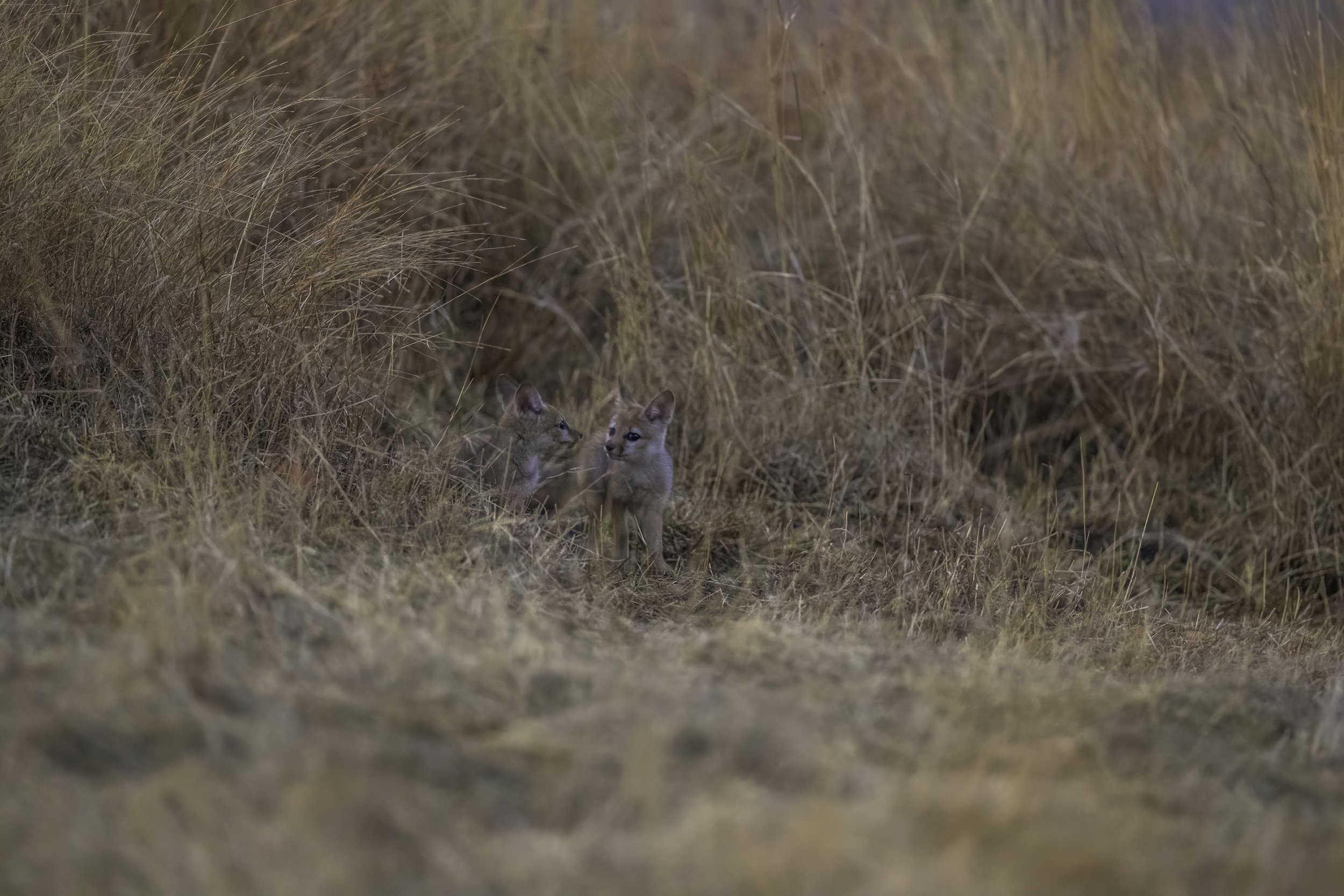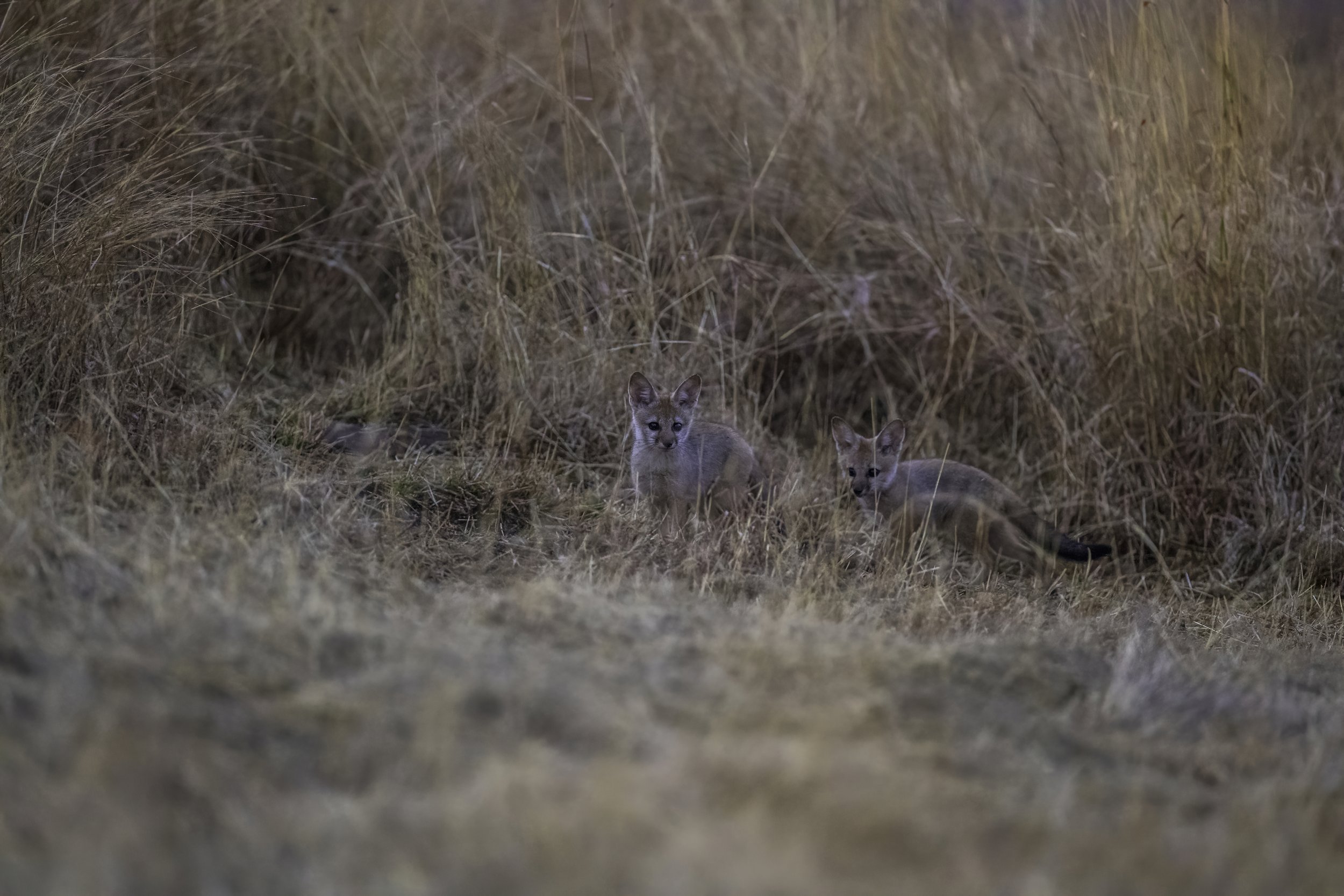Indian Fox/ Bengal Fox
Vulpes bengalensis
Yenkathala/ Ramnathgudpalle Grasslands, Telangana
The Yenkathala/ Enkathala grasslands are home to as many as 191 bird species and numerous wildlife species like the Indian Grey Mongoose. In winter these spectacular grasslands host some beautiful migrant harriers. These harriers migrate from Russia and Eastern Asian countries traveling over 5,000 kilometers to winter here in the dry sub-humid type of grasslands which cover almost the entirety of peninsular India except the Nilgiris. Today my focus is on the smallest wild canid in India - the Indian Fox or the Bengal Fox. The Indian Fox or the Bengal fox is found across large parts of western, central and peninsular India. It can be distinguished from the morphologically similar desert fox based on its black tail-tip. These Indian foxes live in grasslands and agricultural fields, with a diet consisting of rodents and birds.
Yenkathala/ Ramnathgudpalle Grasslands
About 60 kilometers from the capital city of Hyderabad in Telangana lie the Yenkathala or Enkathala grasslands. Apart from the multitude of birds and winter migrants, the rare Indian Grey Wolf has also been spotted here along with a number of foxes - our focus today. The dry deciduous forests ecoregion of the central Deccan Plateau covers much of the state, including Hyderabad. The characteristic vegetation is woodlands of Hardwickia binata and Albizia amara. Over 80% of the original forest cover has been cleared for agriculture, timber harvesting, or cattle grazing, but large blocks of forest can be found in the Nagarjuna Sagar - Srisailam Tiger Reserve and elsewhere. The more humid Eastern Highlands moist deciduous forests cover the Eastern Ghats in the eastern part of the state. The Central Deccan forests have an upper canopy at 15–25 meters, and an understory at 10–15 meters, with little undergrowth.
Grasslands are natural carbon sinks and therefore crucial to the global carbon cycle due to their high rates of productivity, enhanced carbon sequestration rates & geographical extent keeping global temperatures more or less in balance. They are also breeding grounds for many migratory and endangered species like the Indian Grey Wolf of which only about 3,000 are left in the wild. It is a common response from people to think forests when green cover is mentioned but grasslands are of equal import. These open natural ecosystems urgently need attention and government initiatives for protection and conservation. In Telangana, grasslands are located in the districts of Vikarabad, Nizamabad, Khammam, Siddipet and Nalgonda. The wildlife in these fragile ecosystems today face numerous threats like hunting, spread of the canine distemper virus which affects foxes, wolves & several other species, rabies from feral dogs and most crucially, habitat loss.
Read more about the wildlife of these magnificent and fast disappearing grasslands.
Exif: Canon 1Dx Mark ii; EF 600mm f/4 L IS III; 1/50; f/4; ISO 5000; I used my trusty Fenix flashlight for some additional light
Exif: Canon 1Dx Mark ii; EF 600mm f/4 L IS III; 1/1600; f/4; ISO 640
I had already spent a fair bit of time on these grasslands just sitting and watching and gradually the wildlife opened up showing me where they frequented. I had the good fortune to observe the harriers from close proximity without any disturbances and during these sessions I often noticed the Indian Fox making its way back and forth from a point on the grasslands. I could only assume it had one of its many dens there. So I decided to head in there at night and try my luck approaching the den before the foxes were up and about. I didn’t want to disturb them and ensured I was at a safe distance and properly camouflaged to minimise my footprint. The following photos and video are a result of many hours spent from night through into the day waiting and watching these foxes and their two cubs.
Indian Fox/ Bengal Fox
Wild canids in India are among the most under-represented large mammal groups in terms of research and conservation focus. India is home to three fox species and three subspecies - the Indian Fox, Tibetan Sand Fox and the Red Fox, which in turn has three subspecies - the Desert Fox, the Tibetan Red Fox and the Kashmir Red Fox. Globally there are about 23 fox species distributed across six genera. The fox species of India occupy a range of habitats, including arid areas, grasslands, agricultural fields and snow-capped mountains. The Red Fox is the most versatile in terms of habitat adaptation and can reside in open drylands as well as high-altitude areas. Depending on the species, foxes are present throughout the country, but they fail to elicit the same awe that some of the megafauna species do. Many of the threats that India’s wildlife faces today, such as linear intrusion, plastic pollution, habitat modification and reduction of prey base, also impact the foxes of the region. However, discussions that solely focus on the fox family are not that common, making the canids underrepresented in the conservation space.
The only other time I was able to document a fox was in Hokkaido when we tracked and found the Ezo Red Fox on the frozen waters of the Netsuke Bay. Read about it below.
The Indian fox (Vulpes bengalensis), also known as the Bengal fox, is a species of Asian foxes endemic to the Indian subcontinent. This is a medium-sized fox with an elongated muzzle with black hair in small patches on the upper part of the muzzle. Its large, bushy, black-tipped tail is its most prominent feature, accounting for as much as 60% of the length of its body. Usually the tail trails behind but when the fox is running, it carries its tail horizontally, then holds it vertically when making sudden turns. The color of the fox’s coat varies according to the season and within a population but is usually gray on the back and paler on the belly, with dark brown on the ears, with black edges. Their ears are large in comparison to their body and are possibly an adaptation for thermoregulation in their hot and dry habitats.
The Indian/ Bengal fox is more daintily built than the Red fox (Vulpes vulpes), and can readily be recognized by its bushy, black-tipped tail, which is around 50–60% of the length of the head and body. The backs of the ears are dark brown with a black margin, and white inside. The ears have the same colour as the nape or maybe darker, but not having a dark patch as in Vulpes vulpes. Its rhinarium is naked and the lips are black. The muzzle is pointy, and there may be a dark smudged marking along the upper part of muzzle in front of eyes. Extensive variation in coat colour exists across populations and seasonally within populations, but generally varies from grey to pale brown. The head and body length is about 18 inches, with a 10 inch long tail and they typically weigh between 1.8 to 3.2 kg. The genus Vulpes can be separated from Canis and Cuon in the Indian region by the flat forehead between the postorbital processes and not inflated by air cells. The processes themselves are slightly concave with a raised anterior edge (convexly round in other canids). The canine teeth are longer.
Endemic to the Indian subcontinent, these foxes range from the Himalayan foothills and Terai of Nepal through the South portion of the Indian Peninsula (not including the western and eastern Ghats) and from southern and eastern Pakistan to eastern India and southeastern Bangladesh. In Nepal and northeast India, it occurs up to 1,500 meters long. It was not reported from Afghanistan or Iran or from the Western Ghats, India. Its range is bounded by the Himalayas and the Indus River valley. It favors semiarid, flat to undulating land, bush and short grassland habitats. It avoids dense forests, steep terrain, tall grasslands and true deserts. It is relatively widespread in low rainfall areas where the vegetation is usually scrub, thorn or dry deciduous forests, or short grasslands. In the Indian peninsula, the species is confined to plains and open scrub forests. It was considered to be a habitat generalist, but it shows a strong preference for semiarid, short grassland habitats at multiple scales.
These Indian foxes are predominantly crepuscular and nocturnal which is why I decided to go into the grasslands at night. Sometimes individuals may become active during cool periods of daytime, they typically spend warmer daylight hours under vegetation or in subterranean dens. They use three distinct types of den: basic, compact dens with two openings used for short rest periods, complex dens with multiple openings, rooms and escape routes, and dens under rocks or rock crevices. The basic social unit of the Bengal Fox is the breeding pair, formed by a pair of bonds that can last for many years. Larger aggregations may occur while grown pups linger longer than average in the natal community. Other findings indicate that Bengal foxes can sometimes be more social. Female Bengal foxes were reported to share dens during lactation and four adult foxes were seen emerging from the same den.
Indian foxes are not especially suspicious of humans and can be found near human habitation. They are easy to tame. These foxes are sometimes seen basking at vantage points around sunrise or sunset. Bengal foxes live in pairs but usually hunt alone. The basic social unit consists of one breeding pair but bigger groups may form when pups grow up but remain in the area where they were born. Female foxes have been known to share dens while their young are drinking their milk, and four adults have been observed coming out of the same den. Territories consist of a single den or several dens and the foraging area nearby. Dens are reused and become larger over time. Bengal foxes use scratches and scent markings to indicate their territories and the areas where they have recently hunted.
The Indian/ Bengal fox makes a wide range of vocalisations, most commonly a "chattering cry" that seems to have a significant role in establishing territoriality and may also be used as a warning call. This is the call I first heard as soon as I got into the grasslands letting me know that they were up and about and in the general vicinity. They also growl, whimper, whine and make a sound which could be called a growl-bark. In reaction to humans, yapping or baying has also been observed. The Indian fox does not appear to have latrine behaviour, a feature seen in some social canids, in which all members defecate at specific spots. They can be heard howling in the night in groups.
During the day, they tend to rest under shrubs and bushes, except in summer when they rest in dens. Play between kits is typical during the first 3 months and consists of vertical jumps, back arching, foreleg stabs, submissive displays, and play solicitation; the adult male sometimes plays with the young. During my time here I had an amazing time with the kits as they frolicked in the dim light of blue hour. The kits are fully weaned about 3–4 months after emerging from the den. Kit mortality is high during the first few months.
While the Indian/ Bengal fox is common, it usually occurs at low densities across its range, and populations may experience significant fluctuations due to prey abundance and disease (canine distemper virus and rabies, which have been confirmed to cause local population declines in western India). Any human disruptions can be tolerated, but with the increase of human populations and the increased growth of grasslands for agricultural and industrial use, the habitat of the Bengal fox is continually being reduced. The combination of the above causes, combined with disease and/or natural mortality, could potentially cause localised extirpation.
Lack of habitat protection is perhaps the greatest threat to the Bengal fox. For example, in southern India, less than 2% of potential Indian fox habitat is covered under the existing protected area network of the states of Karnataka and Andhra Pradesh . Hunting for its skin and flesh, as well as conversion of its grassland habitat to agriculture, industry, and increasingly bio-fuel plantations, have affected its population density. In addition, its body parts are used in traditional medicine, and in some areas it is eaten. They are hunted by the narikuruva tribes of southern India. In Karnataka, they are captured in rituals conducted during Sankranthi - the transmigration of the sun from one zodiac to another in Indian astronomy..
The populations of India are listed in the CITES Appendix III. The Indian Wildlife Conservation Act (1972 as amended to 2005) forbids the hunting of all wildlife and lists the Indian Fox in Schedule II. It does not apply to any particular category in the wildlife protection legislation of Nepal. It is listed as Least Concern in the IUCN Red List of Threatened Species.
From habitat loss to the depletion of their prey base, India’s foxes face several threats that impact their populations. The Indian Fox and the Desert Fox, for example, today occupy less than 40 and 50 per cent of their original habitats, respectively. Free-ranging dogs are another significant concern for the Desert Fox, Red Fox and the Indian Fox. A 2009 study on the sympatric domestic dogs and Indian Fox in central India noted that dogs may be preventing foxes from accessing agricultural food sources and human-discarded food. While this is not an issue for foxes that reside in native habitats, it could impact fox populations outside protected areas that are increasingly being altered by anthropogenic influences. Another study published in 2014 looked at the prevalence of viral pathogens in free-ranging dogs and Indian Foxes in the Great Indian Bustard Sanctuary, Maharashtra. The study found that exposure to canine parvovirus (CPV) and canine adenovirus (CAV) was 48 and 52 per cent respectively among foxes, and the animals that had an ongoing canine distemper virus infection showed high rates of mortality. The exposure rates among dogs were greater than 70 per cent for all three viruses. Despite the wide geographic distribution of the Red Fox, local populations are affected by habitat modification, causing a decline in their numbers. Additionally, when they live close to human settlements, the foxes forage from discarded waste and food, exposing them to plastic pollution and other toxic substances.
A citizen science initiative called Wild Canids–India Project is documenting foxes and other canids across the country while sharing relevant information about identifying them and understanding their world. Their objective is aimed at making ecological and conservation assessments of wild canids in India. The project focuses on eight species & sub-species of wild canids: dhole, golden jackal, Indian wolf, Tibetan wolf, Indian fox, red fox, desert fox and Tibetan fox. They have also included the striped hyena in the project because of its similarities with wild canids in aspects like natural history, ecological requirements and conservation issues. If you are interested in contributing to this project or learning more about the foxes of our country, share details of your sightings with the project and read more about their conservation scorecards to gain a comprehensive overview of the species. Foxes play an important role in keeping a check on their prey base. Species like the Red Fox also aid in seed dispersal. It is high time that we took notice of these canids and enabled crucial conservation measures through awareness generation.
Follow them on their website and Instagram.
‡‡‡‡‡
On an earlier trip while I was photographing the harriers, late in the evening, almost with the last light, I had seen some harriers chase the Indian Fox which I think was out hunting. At the time I was on the 7D Mark 2 wearing the 100-400mm and the action was too quick to switch to the bigger camera and lens which, anyway, was pointing in a different direction. The harriers started to swoop down and hassled the fox till he fled. I was able to take a few photos of this spectacular moment and experience watching the harriers behave the way they did. My shutter speed was set to match the fox as much as possible, given the extremely low light, and this blurred the high speed harriers.
‡‡‡‡‡
The following gallery consists of photos I got with the Canon 1Dx Mark 2 wearing the 600mm f/4. The fact that I was shooting in the middle of the night and then through into the day ensured I couldn’t use the extenders. Night shooting doesn’t allow for too many options. Visit What’s in my Bag? to know more about the gear I use.
For this first gallery I shot almost in complete darkness using my trusty Fenix flashlight as the primary source of light and intentionally on a lower setting just enough to get the photos and not blind the foxes. My ISO was, for the most part, between 5000 and 12800 which was just about enough to freeze the action as it happened. I also ensured the flash was not pointed directly at the foxes.
This next set was shot at ISO 3200 and no flashlight as there was enough ambient light to grab focus and capture the beautiful moments with the litter as they happened. Fox babies are called kits or a kitten and a group of baby foxes is called a litter. They are named after the creature that delivers baby animals and these tiny mammals, part of the canine family, are not the only animals called kits.
The following gallery is from a few days later and again starting late in the night and shooting well into the morning. The only difference here was there was lesser moonlight and I thought the photos I’d gotten earlier were a little too dark so I decided to bump up the ISO to 12800 along with the flashlight.
And then there was light! I had a wonderful time watching these kits frolic and play, completely at ease with my presence there although they did keep a wary eye out and at every light shift and rustle they’d take a quick look to make sure nothing had moved.
Related Posts










